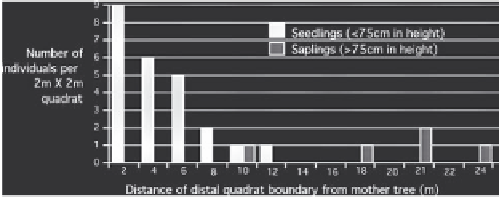Agriculture Reference
In-Depth Information
of islands of the world, discussing how animals and plants
reach islands that either have had a physical connection
to an adjacent mainland colonizing source or that have
never had such a link. The work of Van der Pijl (1972)
on the
Principles of Dispersal in Higher Plants
goes into
great detail on the incredible diversity of mechanisms that
aid seeds in moving from one place to another. These
mechanisms can move an organism only a short distance,
or great distances across amazing barriers of ocean or
desert. They can also get a weed seed to a new field.
An important aspect of dispersal mechanisms is how
many of them seem to provide a selective advantage for
“getting away” from the source of reproduction. This is
illustrated by field studies done on the distribution of
seedlings around “mother trees” in the forests of Costa
Rica. As shown in Figure 13.2, most of the newly germi-
nated seeds and very young seedlings were concentrated
close to the tree, but the older saplings (with potential for
becoming adult, reproductive individuals) were found at
a greater distance. Some intraspecific mechanism (e.g.,
competition, and allelopathy) seems to eliminate seedlings
from near the tree, and does not function at a greater
distance. It is interesting to consider why there is advan-
tage in establishing at some distance from the parent,
especially in relation to resource availability, potential
competition, and susceptibility to predation or disease.
Plant seeds are incorporated into the soil soon after
they fall onto the soil surface, with the largest numbers
found in the upper layers of soil. The population of each
species of seed combines with others to form the
seed
bank
. In cropping systems, the analysis of the weed seed
bank can tell us a great deal about the prior history of
management of a site and the potential problems that
weeds may pose; this information can be important for
designing appropriate management.
Since most crop organisms are dependent on humans
for dispersal, their adaptations for dispersal have become
irrelevant for the most part. Indeed, most crop species have
lost the dispersal mechanisms they had as wild species.
Their seeds have become too large, the seeds have
lost appendages that once facilitated dispersal, or their
inflorescences no longer scatter seed. The loss of dispersal
adaptations is seen particularly in annual crops, whose
seed or grain is the portion of the crop that is harvested.
Establishment
There really is no bare area on the earth that propagules
of plants and animals cannot get to. The incredible diver-
sity of dispersal mechanisms mentioned above makes sure
of that. But once a propagule arrives at a new location, it
most certainly can have problems getting established.
Restricting our attention to plants, a dispersing seed can-
not determine where it will land; so it is the condition of
the site that determines if the propagule can establish.
Seeds fall into a very heterogeneous environment, and
only a fraction of the sites encountered will meet the needs
of the seed. Only those microsites that fulfil the needs of
the seed — the “safe sites” — can support germination
and establishment. The greater the number of a species'
seeds that land in safe sites, the greater the chance of that
species establishing a viable population in the new habitat.
The seedling stage is generally known to be the most
sensitive period in the life cycle of the plant, and is there-
fore a critical stage in the establishment of a new popu-
lation. This is true for crop species, weeds, and plants in
natural ecosystems. A dormant seed can tolerate very dif-
ficult environmental conditions, but once it germinates,
the newly emerged seedling must grow or die. Any one
of the many extremes of environmental conditions the
seedling might face can eliminate it, including drought,
frost, herbivory, and cultivation. Human intervention can
help ensure the successful and uniform establishment of
crop seedlings, but the variability of the environmental
complex still makes this the most sensitive phase for most
crop plant populations. Early juvenile stages of most ani-
mals show the same sensitivity to environmental stress.
Growth and Maturation
Once a seedling has successfully established, its main
“goal” is continued growth. The environment in which
seedlings are located, as well as the genetic potential the
seeds contain, combine to determine just how quickly they
will grow. In natural ecosystems, environmental factors
such as drought or competition for light generally limit
the growth process at some phase of the plants' develop-
ment. If these factors become too extreme, individuals in
the population will die.
Plants generally grow fastest, as measured by net bio-
mass accumulated over time, in the early stages of growth.
Their rate of growth slows as maturation begins — more
energy is allocated to maintenance and the production of
reproductive organs than to the production of new plant
tissue. Growth may also slow if the resources available
for each member of the population become limiting.
The time period from germination to maturity can
range from a matter of days for some annuals to several
9
8
7
6
5
4
3
2
1
0
Seedlings ( <75cm in height)
Saplings ( >75cm in height)
Number of
individuals per
2m × 2m
quadrat
2
4
6
8
10
12
14
16
18
20
21
22
24
Distance of distal quadrat boundary from mother tree (m)
FIGURE 13.2
Distribution of seedlings and saplings of
Gavilan
schizolobium
on a westerly strip transect away from
the mother tree, Rincon de Osa, Costa Rica.
Data from Ewert
and Gliessman, 1972.





Search WWH ::

Custom Search